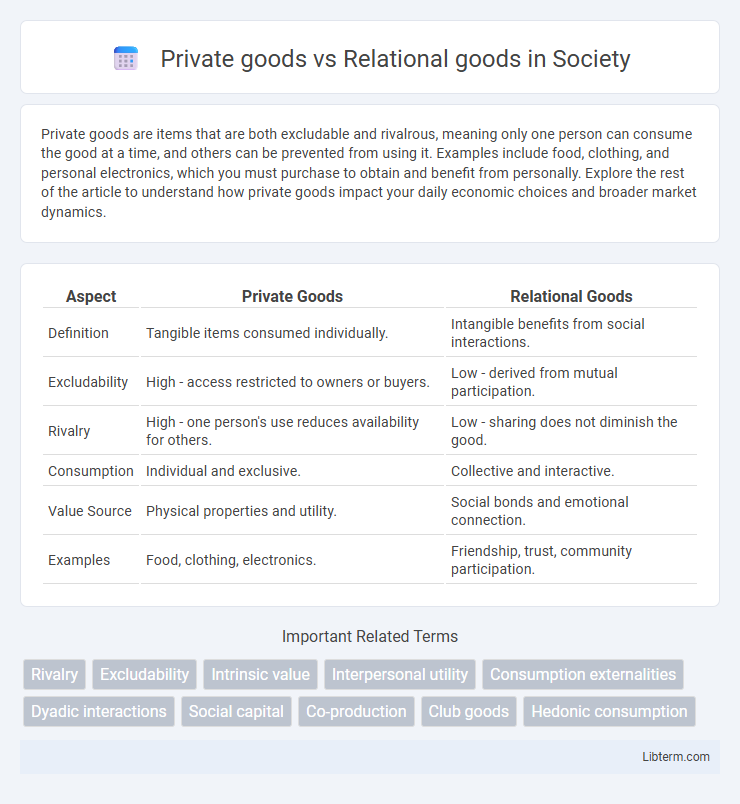Private goods are items that are both excludable and rivalrous, meaning only one person can consume the good at a time, and others can be prevented from using it. Examples include food, clothing, and personal electronics, which you must purchase to obtain and benefit from personally. Explore the rest of the article to understand how private goods impact your daily economic choices and broader market dynamics.
Table of Comparison
| Aspect | Private Goods | Relational Goods |
|---|---|---|
| Definition | Tangible items consumed individually. | Intangible benefits from social interactions. |
| Excludability | High - access restricted to owners or buyers. | Low - derived from mutual participation. |
| Rivalry | High - one person's use reduces availability for others. | Low - sharing does not diminish the good. |
| Consumption | Individual and exclusive. | Collective and interactive. |
| Value Source | Physical properties and utility. | Social bonds and emotional connection. |
| Examples | Food, clothing, electronics. | Friendship, trust, community participation. |
Understanding Private Goods: Definition and Key Features
Private goods are products or services characterized by excludability and rivalry, meaning consumption by one individual prevents others from using the same item. Key features include ownership rights, market-based pricing, and the ability to exclude non-payers, which differentiate them from public or relational goods. Examples of private goods include food, clothing, and personal electronics, where individual consumption directly affects availability for others.
What Are Relational Goods? Meaning and Characteristics
Relational goods are intangible benefits derived from social interactions and relationships, emphasizing shared experiences and mutual cooperation. These goods differ from private goods as they cannot be consumed individually and are inherently dependent on the presence and participation of others, fostering social bonds and community cohesion. Characteristics of relational goods include non-excludability among participants, joint consumption, and the creation of positive externalities that enhance emotional well-being and social capital.
The Economics of Private Goods: Ownership and Consumption
Private goods are characterized by exclusive ownership and rivalrous consumption, meaning one individual's use reduces availability for others and access is restricted to paying consumers. Economic analysis of private goods hinges on property rights, efficient allocation through market mechanisms, and price as a signal of scarcity and value. Consumption decisions for private goods directly affect individual utility without positive externalities or shared benefits inherent in relational goods.
How Relational Goods Foster Social Connections
Relational goods, such as shared experiences and cooperative activities, foster social connections by encouraging interaction, trust, and mutual support among individuals. These goods thrive in environments where collaboration and communication are prioritized, enhancing community cohesion and emotional well-being. Unlike private goods, which are individually consumed and offer personal satisfaction, relational goods create lasting bonds and collective value that promote social capital.
Main Differences Between Private and Relational Goods
Private goods are tangible products characterized by excludability and rivalry, meaning consumption by one individual reduces availability for others and access can be restricted. Relational goods, unlike private goods, derive value from social interactions and relationships, making them non-excludable and non-rivalrous as their benefits increase through shared experiences. The primary difference lies in consumption impact: private goods focus on individual ownership and utility, whereas relational goods emphasize social connection and mutual enjoyment.
Examples of Private Goods in Everyday Life
Private goods are tangible items that are both excludable and rivalrous, meaning consumption by one individual prevents others from using them. Common examples include food, clothing, cars, and smartphones, which are purchased and owned individually. These goods contrast with relational goods, which derive value from social interactions and shared experiences rather than individual ownership.
Real-World Instances of Relational Goods
Relational goods arise from social interactions and shared experiences, such as friendship, teamwork, and community participation, creating value that cannot be privately owned or traded like private goods. Examples include the trust built through collaborative work environments, the emotional support found in close-knit communities, and the unique enjoyment derived from family gatherings, which enhance individual wellbeing beyond material consumption. These instances demonstrate how relational goods contribute to social capital and collective happiness, emphasizing the importance of relationships in economic and social analysis.
Impact of Private vs Relational Goods on Well-being
Private goods, characterized by their exclusivity and individual consumption, primarily enhance material well-being through tangible benefits and personal satisfaction. Relational goods, arising from social interactions and shared experiences, significantly contribute to emotional well-being and life satisfaction by fostering social bonds and community belonging. Research shows that while private goods impact temporary happiness, relational goods have a more profound and lasting effect on overall well-being and mental health.
Challenges in Valuing Relational Goods Economically
Valuing relational goods economically presents challenges due to their intangible nature and dependence on interpersonal relationships, which resist quantification through traditional market metrics. Unlike private goods that have clear prices and ownership rights, relational goods involve shared experiences and social bonds that cannot be easily measured or exchanged. This intrinsic complexity complicates efforts to incorporate relational goods into economic models or policy decisions, necessitating alternative valuation methods like qualitative assessments or social indicators.
Future Trends: Balancing Private and Relational Goods in Society
Emerging future trends emphasize a growing need to balance private goods, such as personal technology and consumer products, with relational goods that foster social connections and community well-being. Innovations in virtual reality and social platforms aim to integrate private consumption with enhanced interpersonal experiences, supporting mental health and social capital. Policymakers and businesses increasingly prioritize models that create value through both individual ownership and shared relational satisfaction.
Private goods Infographic

 libterm.com
libterm.com